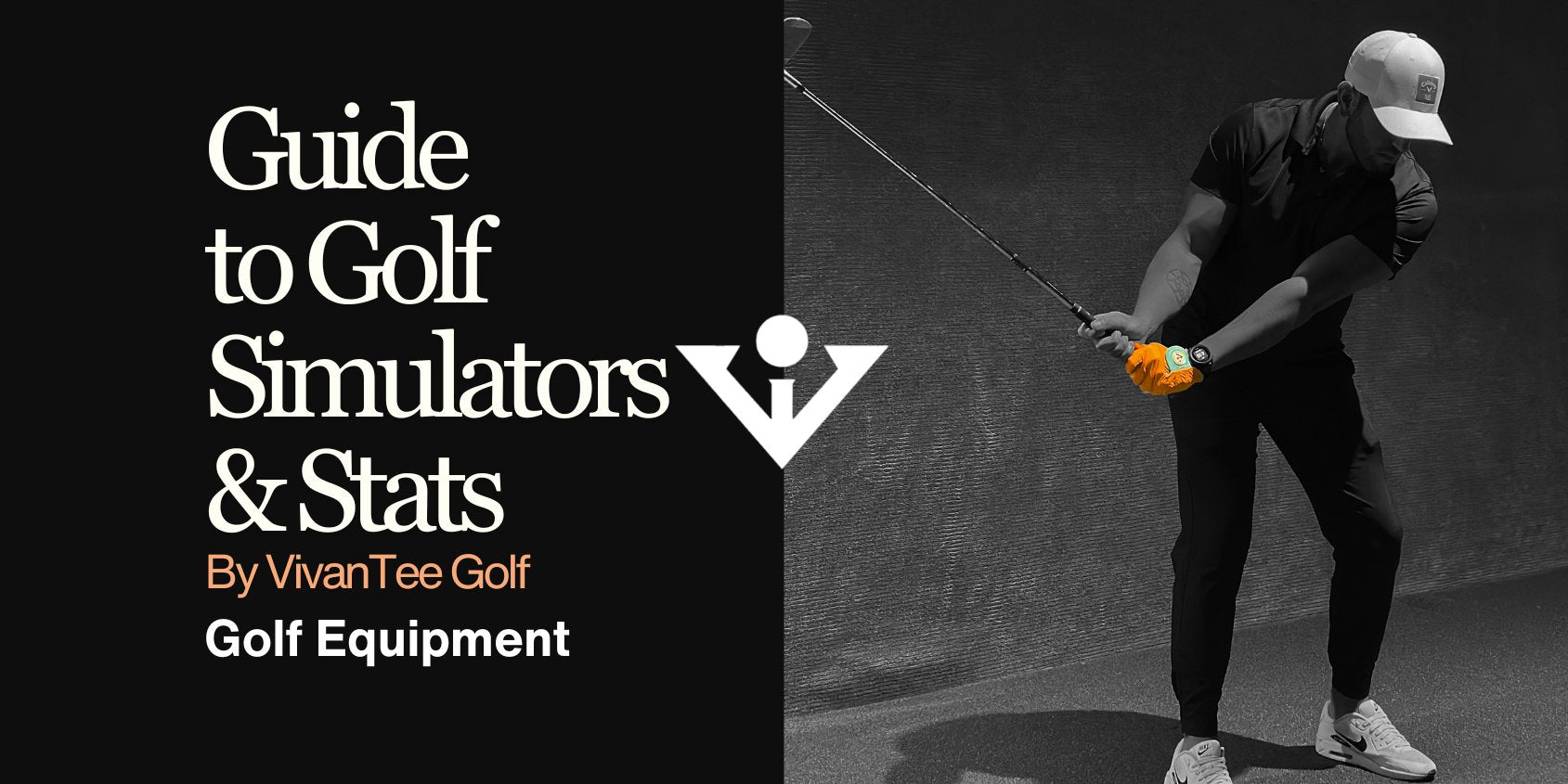
Guide to Golf Simulators and Stats Explained
Top Golf Simulator Picks and Stats Explained
Introduction to Golf Simulators
After a year and a half using a golf simulator almost daily, I have continued to develop my understanding of simulators, and wanted to share this knowledge with our community. Golf simulators today fulfill a variety of functions. Their decreasing costs have led to a surge in purchases, with many individuals installing them in garages, basements, or sheds. These simulators not only allow you to virtually explore any golf course around the globe, but they also serve as an invaluable tool to improve your game and pinpoint areas of weakness. Many bars and venues, including 5iron, have embraced this technology as well. Combining the statistical insights provided by the simulators with video recordings of your swings can facilitate substantial improvements in your gameplay on the fairway. In this article, we will delve into the basics of golf simulators, offer reviews for potential purchases, and discuss the implications of simulator stats on the evolution of your game.
Benefits of Using a Golf Simulator
Convenience: Year round play of course if you are somewhere that gets cold like the North East, or somewhere with a lot of rain. You don't have to make a tee time, and the course moves far more quickly than a real course. Don't need to locate your ball, walk/cart to it, each person switches off as soon as the other is done, etc.
Data Analysis and Skill Improvement: Comprehensive data analysis to analyze your swing, understand things like swing speed, launch angle, areas of improvement, and ensuring you are purchasing the correct equipment.
Golf Simulator Sensor Types
Radar-Based Sensors
Trackman: Uses Doppler radar technology to track the full trajectory of both the ball and the clubhead.
FlightScope: Another radar-based system offering comprehensive data on ball flight and swing.
Optical Sensors
Foresight Sports: Uses high-speed cameras to capture ball flight and club data.
SkyTrak: A photometric launch monitor that captures high-speed images of the ball immediately after impact to measure parameters such as ball speed, launch angle, and spin rate.
Infrared Sensors
Hybrid Sensors
Full Swing Simulators: Incorporates both infrared and high-speed cameras to offer a comprehensive analysis of both club and ball data.
AboutGolf: AboutGolf employs its proprietary 3Trak® technology, a hybrid system that integrates high-speed cameras and optical tracking sensors.
Which golf simulators are best?
Cost of a Golf Simulator
Costs can range quite a bit from $1,000 to $50,000. This will depend majorly on what you are looking for from a quality perspective, how often you will use it, and what is most important from a usage perspective. Some sensors are better at tracking certain stats, some are better for virtual course play, etc.
Brands and features
Determining the "best" and "most accurate" golf brand largely depends on what specific aspects of the game you're looking to monitor and your budget.
TrackMan - "Best Golf Simulator for Data Tracking"
Cost: Ranging between $20,000 and $50,000 depending upon the specific model and accompanying features.
Technology: Utilizes the advanced Doppler radar technology to monitor and analyze both ball and club data with high precision.
Key Features: Acknowledged for its exceptionally accurate ball flight and clubhead tracking capabilities, TrackMan is a favored choice among professionals and PGA Tour players. Its technology is robust, offering highly detailed data that can significantly aid in training and enhancing one's game. The versatility of TrackMan allows it to be a valuable asset in various settings, including training centers, professional tournaments, and high-end home setups.
Analysis Offered: TrackMan offers an extensive range of analytics that can delve deep into your game's intricacies. It provides vital statistics including ball speed, launch angle, spin rate, and clubhead speed. Additionally, it offers insights into the smash factor, dynamic loft, and angle of attack among other nuanced data, assisting players in understanding and improving their swing mechanics and overall game performance.
Pros:
Highly Accurate: Uses Doppler radar technology which offers highly accurate data on both ball and club metrics.
Preferred by Professionals: Widely used and endorsed by PGA Tour players and coaches.
Comprehensive Analysis: Offers a broad spectrum of data points including ball speed, spin rate, angle of attack, and more.
Versatility: Can be used both indoors and outdoors, providing flexibility in training environments.
Cons:
Costly: One of the most expensive options in the market, potentially prohibitive for casual golf enthusiasts.
Complex Setup: The setup can be intricate and might require professional installation.
Steep Learning Curve: The extensive data and analysis offered can be overwhelming for beginners.

FlightScope "Best Versatile Golf Simulator Option"
Cost: Ranging between $10,000 and $20,000
Technology: Radar (3D Doppler tracking radar).
Key Features: FlightScope is a versatile choice in the golf simulator market, offering products that cater to both amateurs and professionals with varying levels of detail and price points. Recognized for its high accuracy and reliability, it's a preferred tool for individuals and training centers looking to get in-depth insights into their golf game. FlightScope integrates seamlessly with mobile devices and personal computers, allowing for real-time feedback and detailed session analyses.
Analysis Offered: Like other industry leaders, FlightScope provides comprehensive data on both ball flight and swing mechanics. Golfers can access critical data such as ball speed, launch angle, spin rate, carry distance, and clubhead speed, among other parameters. This rich set of data helps golfers identify areas of improvement and work on their game more effectively.
Pros:
Flexible Options: Offers a range of products with varying levels of sophistication and price points.
Reliable Accuracy: Provides reliable data accuracy, particularly in the mid to high-range products.
Portable Options: Offers portable devices that are easy to transport and set up in various locations.
User-Friendly Interface: Features interfaces that are generally user-friendly, accommodating both amateurs and professionals.
Cons:
Varying Accuracy: The accuracy can vary between the lower-end and higher-end models.
Additional Costs for Features: Some advanced features and analysis tools may require additional costs.
Compatibility Issues: May have compatibility issues with certain third-party software or applications.

AboutGolf "Best Immersive Golf Simulator Option"
Cost: $35,000 to $100,000
Technology: 3Trak® technology integrates high-speed cameras and optical tracking sensors.
Key Features: Renowned for offering a realistic and immersive golf simulation experience, AboutGolf is a preferred choice for both commercial setups and high-end home installations. It combines advanced ball and club tracking technology with high-fidelity 3D graphics to recreate an authentic golfing experience indoors. Moreover, its modular design allows for custom installations, fitting various spaces and catering to individual needs.
Analysis Offered: Provides detailed analytics to help golfers improve their game, including metrics such as ball speed, launch angle, spin rate, clubhead speed, and more. The system also integrates with learning and training modules, making it an invaluable tool for golfers looking to analyze and enhance their performance on a deeper level.
Pros:
Immersive Experience: Offers high-fidelity 3D graphics for a realistic and immersive golfing experience.
Detailed Analytics: Provides in-depth analytics for serious golfers looking to hone their skills.
Customizable Setups: Features modular designs that can be customized to fit various spaces.
Integrated Learning Modules: Offers integrated learning and training modules to enhance the learning experience.
Cons:
High Initial Investment: The pricing for the setups is on the higher end of the spectrum.
Space Requirements: The immersive experience might require a substantial amount of space for setup.
Maintenance: High-tech components might necessitate regular maintenance and updates.

SkyTrak - "Best Affordable Golf Simulator Option"
Cost: $2,000 to $4,000 for the basic setup, with additional costs for premium software packages and accessories.
Technology: Utilizes high-speed cameras and photometric technology to accurately capture and analyze ball flight data and swing metrics.
Key Features: SkyTrak is celebrated for its user-friendly interface and affordability, making it a popular choice for home setups and golf enthusiasts on a budget. Despite its lower price point, it offers a realistic golf simulation experience with a decent level of accuracy. The system is portable, easy to set up, and integrates well with various golf simulation software options available in the market, offering a customizable experience to its users.
Analysis Offered: SkyTrak offers a robust analysis suite, providing golfers with critical data such as ball speed, launch angle, backspin, sidespin, and carry distance. This data helps golfers to understand their swing better and work on areas that need improvement. Moreover, it also offers features like game improvement modules and challenges to make the learning process engaging and fun.
Pros:
Affordability: Offers a more budget-friendly option compared to other high-end golf simulators.
Portable and Compact: Easy to set up and transport, making it a flexible choice for home use.
Interactive Games and Challenges: Features interactive games and challenges that make the learning process engaging.
Good Entry-Level Option: A popular choice for beginners and amateur golfers looking to get started with simulation golf.
Cons:
Limited Data Points: May offer fewer data points and analysis compared to premium options.
Lesser Accuracy: While offering good accuracy, it might be slightly lesser compared to premium options like TrackMan.
Latency Issues: Some users have reported slight latency issues in data reporting.
Subscription Fees: Some features and software integrations require an ongoing subscription fee.

Personal Experiences
Having access to a simulator in my building, I cannot praise the opportunity to use a simulator enough. My personal experience with going to 5iron with friends and using their Trackmans and the AboutGolf simulator, which is an amenity in my building, has enabled me to consistently enhance my game with detailed statistics.
As AboutGolf is renowned for the immersive experience it offers, from my experience, it definitely feels more lifelike compared to the Trackman. The realistic representation of the courses and the accurate depiction of ball flight that I observe in real life are better replicated on the AboutGolf simulator. However, Trackman seems to offer more precision in the data, as there have been numerous instances where the AboutGolf system misreads shots. For example, a number of times showed a 7-iron shot traveling 250 yards, which is clearly an error.
As evidenced by the statistics I've shared below (from the AboutGolf simulator), there are several occasions when the simulator fails to capture the club head speed accurately if at all. This is an issue I haven't encountered during my time using Trackmans. Despite this, such glitches are rare exceptions. Under the assumptions that the prices are the same, I would certainly opt for AboutGolf, as the overall experience it provides is more enjoyable in my view.
Golf Simulator Stats Explained

Example stats from AboutGolf simulator

Example stats from Trackman for PGA tour averages

Example stats from Trackman for LGPA tour averages
Club Head Swing Speed
Swing speed is arguably the most frequently discussed statistic on the golf course. You'll hear conversations about it on every fairway, and rightly so. It plays a vital role in determining the appropriate golf equipment that is suitable for your swing. Most notably shafts that you should be using and the influence of your overall ball flight.
For example, a fast swing speed combined with a shaft that is too flexible can result in excessive loft on your ball. Conversely, if you have a slower swing speed and use a shaft that is too stiff, your ball may barely get airborne. There's much to think upon, and we always recommend getting a proper fitting to fine-tune your equipment.
However, employing a golf simulator can offer substantial insight into your baseline performance, helping you to identify an ideal starting point for improvements.

Golf Ball Speed and "Smash Factor"
Golf ball speed is pretty self explanatory as it is the MPH speed of your ball coming off of your club. It's important to note that even if you have a tour-level club swing speed of 113 MPH, failing to generate a ball speed exceeding 160-170 MPH indicates inefficiency in your swing. This could be attributed to several factors such as striking the ball incorrectly on the driver face, generating excessive backspin due to casting, using an unsuitable ball, among others. The "smash factor" is a critical statistic that reveals the power generated from your club swing speed to the ball. Essentially, it is the ratio of your ball speed to your swing speed. The goal is for a smash factor at 1.5 for the driver, meaning that with a swing speed of 100 MPH, your goal should be to achieve a ball speed of 150 MPH.
We delve deeper into the intricacies of golf ball speeds here in this blog, shedding light on how you can enhance your ball speed.
To better understand and rectify this, pair this stat with a slow-motion video analysis of your swing. This combination can provide a comprehensive view of your performance and areas where you can improve.
What is casting AKA "throwing the club" or "early release"?
Casting in golf refers to the early release of the wrists during the downswing, causing a loss of power and often resulting in a weak impact. When a golfer "casts" the club, it means they are unhinging their wrists too early, similar to the motion of casting a fishing line. This action is undesirable because it eliminates the potential for a powerful, compressive strike on the golf ball.
Launch Angle or Vertical Launch Angle
This will be the angle the ball comes off the club at. Why is launch angle important? Because if your launch angle is too high, on a driver anywhere from 14-19 degrees, you will lose substantial amount of distance. Can also mean you are casting, or have the ball teed too high, or too low. Scooping the ball or not compressing it as well, always a variety of factors to consider, but it gives you indications of a correctable flaw in your swing. The launch angle decreases from your driver as you go down in clubs chart below.
Spin Rate
This includes measurements of side spin and backspin rate. High backspin can indicate several issues: a shaft that isn't stiff enough for your swing speed, improper contact with the club face, an early release, the type of ball being used, among others. Excessive backspin can generate too much loft, leading to a loss in distance. This happens because your power is being converted into backspin, which causes the ball to ascend too high, consequently reducing your yardage off the tee or with iron shots.
Carry Distance
How far your ball is in flight. This is helpful because on the course the elevation is never the same, so total distance is harder to take into consideration as downhill will give you more roll, and uphill less. If all your other stats are optimized, spin rate, ball speed, swing speed, and launch angle, you will maximize your carry distance for the most efficient swing possible. Perfection is hard to achieve, so don't beat yourself up over it, just focus on continued improvement, drills, and getting better!

Offline & Dispersion
Dispersion measures how far offline you are from the center. If you find that most of your shots veer to the left, this could be a result of an inside-out swing path. Dispersion takes into account the deviation in distance either to the right or to the left within a given set of shots. The average dispersion for a PGA professional is around 65 yards with a driver, implying that, on average, they are approximately 32.5 yards off to the left or right.
If you tend to slice the ball, it could be caused by several factors, including an outside-in swing path or an open club face, among other issues.
Conclusion
Wrapping it all up, diving into the world of golf simulators is an interesting topic as the technology has only advanced over the past few decades. We are lucky to have such amazing technology at our finger tips as it helps us adapt our game and enjoy golf year round. The current market offers a variety of options way more than the ones we covered here, but these were our top choices. These state-of-the-art simulators not only provide an avenue for leisurely play but also offer a potent tool to hone your skills, backed by detailed analytics to guide your journey to becoming a better golfer.
As you navigate through the vibrant ecosystem of golf simulators, it's essential to consider factors such as technology, accuracy, and your personal preferences in terms of gameplay experience and statistical analysis. Remember, the best simulator for you is one that aligns with your individual goals and requirements, whether that means recreating a genuine golf experience at home or embarking on a data-driven journey to refine your skills on the green.
Follow our newsletter for more golf related content, exclusive offers and updates on our products, and more. And of course, if you are looking for a stylish golf glove with magnetic ball markers, go check out our glove collection inspired by NYC.





Leave a comment
This site is protected by hCaptcha and the hCaptcha Privacy Policy and Terms of Service apply.